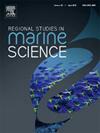Sediment particle sizes and river discharge implications on shoreline change along Anlo Beach, Ghana
IF 2.1
4区 环境科学与生态学
Q3 ECOLOGY
引用次数: 0
Abstract
Anthropogenic activities within river catchments significantly alter river flow patterns and sediment discharge into coastal zones, impacting coastal systems and their management. To address the persistent erosion of Anlo Beach in Ghana, this study aims to evaluate the role of sediment discharge from the Pra River in shaping the beach's evolution. Specifically, the research seeks to quantify sediment inputs, assess shoreline changes, and identify the factors driving coastal erosion. Using a combination of Landsat 7, 8, 9, and Sentinel-2 satellite imagery over a 10-year period, alongside in situ measurements of flow velocities, sediment load, river bathymetry, and beach aerial photos over six months (May-October, 2022), we analysed shoreline dynamics and sediment characteristics. Satellite data were processed using the CoastSat toolkit, while in situ data were analysed using sediment discharge equations and protocols in ArcMap. Results reveal an average shoreline erosion rate of 5–15 m/year over the past decade, with a sediment loss of approximately 100,000 m³ in the last six months. The sediment transported by the Pra River to Anlo Beach is predominantly very fine-grained, likely due to upstream small-scale mining activities, which reduces effective sediment deposition and exacerbate erosion. The findings underscore an urgent need for targeted management interventions to mitigate coastal erosion and socio-economic impacts on the Anlo Beach community.
求助全文
约1分钟内获得全文
求助全文
来源期刊

Regional Studies in Marine Science
Agricultural and Biological Sciences-Ecology, Evolution, Behavior and Systematics
CiteScore
3.90
自引率
4.80%
发文量
336
审稿时长
69 days
期刊介绍:
REGIONAL STUDIES IN MARINE SCIENCE will publish scientifically sound papers on regional aspects of maritime and marine resources in estuaries, coastal zones, continental shelf, the seas and oceans.
 求助内容:
求助内容: 应助结果提醒方式:
应助结果提醒方式:


